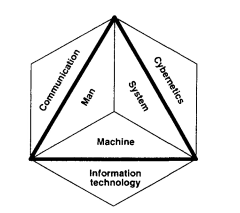Since the late 1960s, computer science has been an important topic of study in all major universities around the world. This subject has its origin in the pure technological areas of computer engineering (‘computer science’), computer mathematics (‘computing science’) and numerical analysis, etc. Informatics, with its roots in computer science is a concatenation of the words information and technology. Enjoying features of both, it sits between science and technology and has a broad interface to neighbouring areas such as those shown in Figure 10.1.
As an area of design, informatics concerns the overarching construction of information technology, IT, adapted to various user areas. The domain includes supporting methodology and techniques for the analysis, development and management of information systems. As such, it covers the whole spectrum from social science to mathematics. In a sense, informatics has more in common with other sciences of design (e.g. architecture) than with its formal origin. Design concerns the shape, the ergonomics and the final user- friendliness of the actual system. Here, technology alone cannot be allowed to decide; the final result must be what customers and users want. For example, the needs of a general user will be widely different from those of a computer scientist working in academia.

Figure 10.1 Informatics and its intersection with related areas.
Thus political, social, cultural, ecological and especially psychological considerations must be taken into account. A typical problem that involves informatics relates to transportation in medical care. Should the patient be transported to the practitioner, or should the practitioner be transported to the patient? This question can be solved by tele-medicine.
As an applied systems science concerned with user requirements, informatics must necessarily put concrete and pragmatic knowledge before general theories. Therefore, values and preferences are thoroughly dealt with, being the basis for human technological needs. Questions regarding threats to human integrity are a priority concern in informatics.
The most characteristic feature of informatics is, however, how often and crucially the area changes its focus. While social philosophers speculate about the consequences of a certain information technology, the development has already moved in another direction.
By tinkering, users discover new areas of use, something not intended by the designers. No doubt, the use of modern IT will transform our present society just as thoroughly as the industrial revolution changed the society of its time. This transformation towards an IT-based knowledge society has been called ‘The Third Wave’ (Toffler 1980).
In such a revolution, some specific circumstances must be observed. One is the difference between ordinary mail and electronic mail, E-mail (including Fax). With ordinary mail you try to reach a place, while by the use of E-mail you try to reach a person. Another is a growing need, not for more, but for less information — delivered, however, with an absolute freedom of choice.
In order to make the vast sphere of informatics presentable in a book such as this, the area discussed here is restricted to some major parts of tele-informatics, an area of great current interest. Teleinformatics includes knowledge about electronic transference systems for data and information of all kinds. French-speaking countries have coined the name télématique, while Scandinavian countries use the name telematik.
The international background of today’s informatics is an ongoing intense period of development where three global multimillion dollar industrial sectors are just now merging. These are the telecom- munications industry, the electronics industry and the media/ entertainment industry. The integration exists on two planes, on the one hand by merger and acquisition and on the other by technological integration of voice, picture, data and information.
One of the main reasons behind the technological integration is digital compression, making possible vastly more ‘traffic’ on the existing tele- and data-communication networks. Simultaneously, the networks are being rebuilt and augmented into something described as the ‘electronic highway’.
Source: Skyttner Lars (2006), General Systems Theory: Problems, Perspectives, Practice, Wspc, 2nd Edition.
